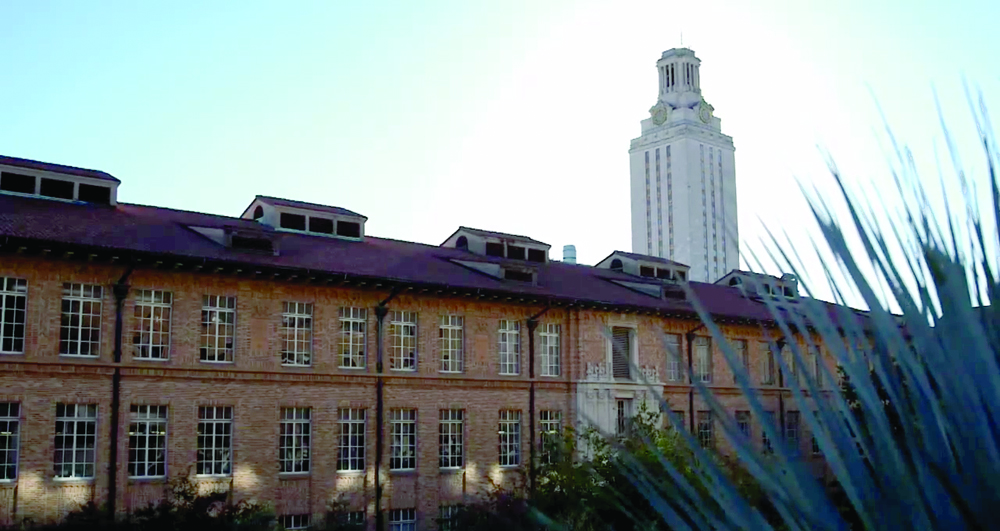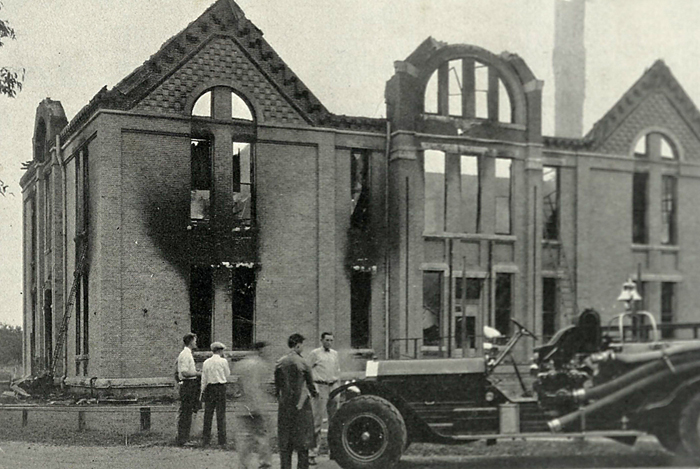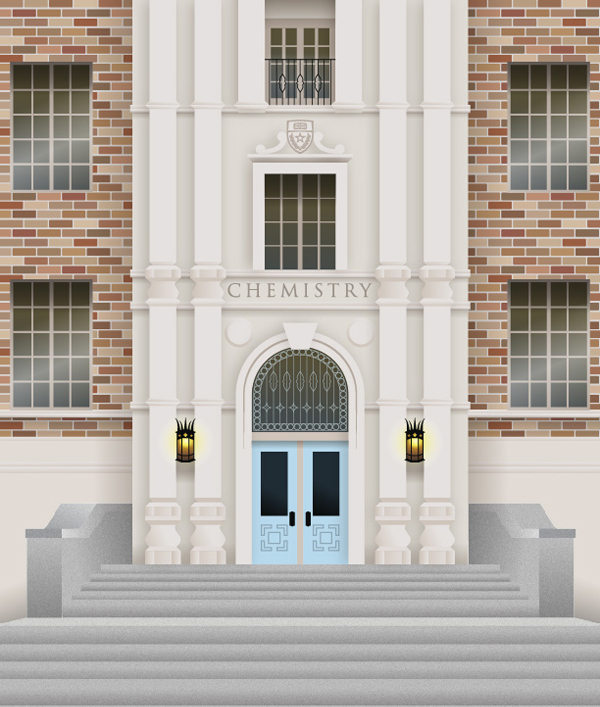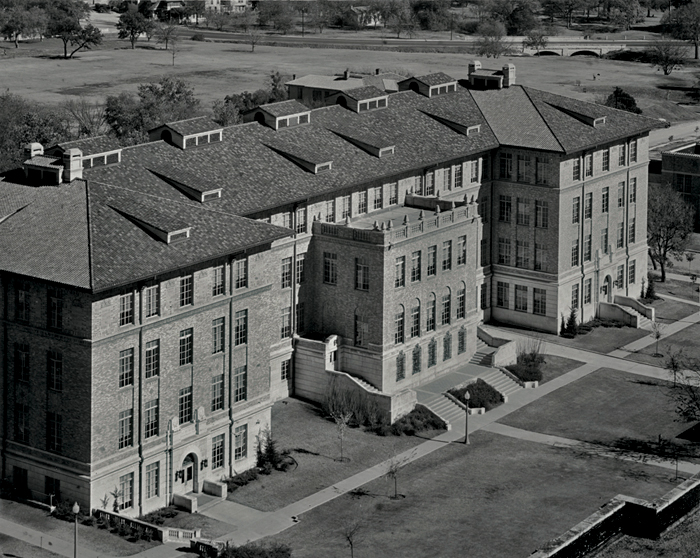Since its completion in 1931, Welch Hall has hosted chemists and many other members of the College of Natural Sciences family. With the Texas Legislature currently weighing a bill to help renovate Welch, we look at some history and fun facts about a place on campus that nearly every Longhorn knows well.
1. Everything’s bigger in Welch Hall.
One of UT Austin’s largest buildings, Welch is someplace nearly every Longhorn takes at least a class or two in before graduating. It sees 10,000 or more students every day, and faculty there attract research awards that generate roughly $12 million per year in funding.

2. Welch rose from the ashes.
What became Welch Hall was constructed after an earlier UT chemistry building burned down in 1926. The fire, caused by aging wiring, sparked a blaze. As stored chemicals ignited, a series of colorful explosions followed. Faculty and firefighters fortunately managed to save most of the building’s books and journals, which made their way to a new building: what became Welch Hall. Oddly enough, 70 years later almost to the day, Welch Hall was the site of a six-alarm fire that prompted the need for later renovations in a section of the building.

3. Its cool architectural features date back over 80 years.
The building that replaced the burned-down chemistry lab (now Welch, then called the Chemistry Building) was built with several eye-catching elements. You can still find many of them there today, as the UT library notes:
- The names of famous early chemists are inscribed in panels running around the 5th floor exterior.
- The Gothic lamps on the exterior of the building were copies of those found on the Palazzo Strozzi in Florence, Italy.
- There’s a decorative painted beam ceiling in the Convocation Center in room 2.122.

4. Welch has three distinct wings.
Eventually, more space was needed, so in 1959, a new west wing was constructed. It was followed in 1978 by an even larger addition that runs south along Speedway. This last addition included climate-controlled greenhouses and growth chambers on the sixth floor. In 1974 the Chemistry Building was rechristened Welch Hall after Houston philanthropist Robert Alonzo Welch.

5. Welch has amazing, little-known hideaways that science-lovers dig.
Welch Hall is home to hidden gems. In our Head Room video series about places in the College of Natural Sciences worth knowing about, for example, we featured the glassblowing shop in Welch Hall. The shop helps meet chemists' need for various shapes and styles of glass that make it possible to carry out research. As The Alcalde has noted, "Glass shops have become increasingly rare at national universities."
6. Welch needs updating.
Not everything ages gracefully. Whether you were last in Welch in the '50s, the '80s, or last year, you probably noticed excessive wear and tear has taken its toll on the classrooms, the teaching labs, and the research spaces throughout the building. This summer, the 1929 wing will undergo significant renovations to include new classrooms and modern research and teaching labs, as well as dedicated labs for the Freshman Research Initiative.
A bill before the Texas Legislature would allow for critical renovations and modernization of the HVAC and air-handling system in the '59 and '78 wings as well. To learn about these plans, please check out the Texas Exes’ 2015 priority for capital investment.
|
|
|



















Comments 8
From the color scheme in the elevators, they were installed in the early'70s.
the Chemistry Library is the only publicly-available, chemical-information resource in town. However, I often wish that I could return to read in the Chemical Library that was in the middle of 3rd floor, with it's painted beams on the ceiling. It was closer to a monastery and helped you feel like you were the continuation of a long line of chemists, not simply a pioneer in this Brave New World.
The Old Library reading room (currently WEL 4.132B) is still there, nicely restored to its original appearance, and serves as a departmental seminar and meeting space. While the room is not accessible to the public, anyone wishing a private tour can contact the Mallet Chemistry Library to make an appointment. It will be closed for the duration of the 1929 wing renovation, however.
Where are the spirits of Aubry Skinner and Johnny, the glassblower who taught many of us to do elementary glass blowing? They need at least a plaque
As a grad student in 1980-82– my office was in the hallway leading into the old Mallet Library. That room was the grad student lounge with nice sofas-for taking naps. However the ornamental beams on the ceiling were incredible. When my daughter was in the 2nd grade she wrote an essay where she mentioned that if schools looked like this room, then more students would love learning!
While at the Mallet Library in the '80s, I intended to checkout an organic chemistry book written in "Spanish" that I had seeing on the bookshelf. I browsed through the book and got up to ask the librarian if they had a similar book written in more "modern Spanish" instead of in the "old Spanish" version I had on my hands. The librarian tactfully informed me that I was trying to read an organic chemistry book written in Portuguese. I was surprised since I had understood most of what I had read. What an embarrassing moment for a college kid. This event gave me the confidence I needed to read all chemistry books in English. I also gained a new library advocate when needing to checkout reserve materials. Welch Hall is in the heart of UT; I am glad is going to receive well-needed renovation.
Dorca ZS: The 1929 Wing renovations have been completed and the space is beautiful. We are hosting an Open House and dedication event on 4/20/17 from 5-7pm if you can join us. As well, I am happy to meet you on campus and give you a tour anytime! Email me at kelsey.evans@mail.utexas.edu!
In 1958 I was a graduate student senior in the department of Chemistry at UT. I was also the master alchemist in Alpha chi Sigma which was the professional chemistry fraternity that UT had at that time. We had approximately 29 members, most of whom lived in the fraternity house close to campus. Most of them were returning Korean War Vets. Dr. Royston Roberts was the faculty advisor for the group. In the Spring of 1958 we held our initiation ceremony of new members in the basement of Welch Hall. There were approximately 13 new members, one of whom was Dr. Roland Pettit who had recently arrived from Australia as a Chemistry department faculty member. He was initiated into Alpha Chi Sigma in that Welch Hall initiation. As a single male, he spent many evenings playing poker at the Alpha Chi Sigma House. Meetings were held either at the fraternity house or at Welch Hall. Phil Bailey, Royston Roberts, Roland Pettit and Norman Hackerman were all active members of the fraternity. It is with regret that I understand that the fraternity is no longer active on campus.
Dr. John H. Harrison IV, B.S. 1958, PhD 1964.
Harvard Med School Post Doc. 1964-1967
U.N.C. at Chapel Hill, Dept. of Chemistry 1967-1997